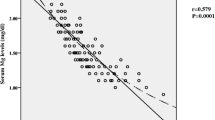Summary
Intraerythrocytic K+ and Na+ were determined to study their significance in diagnosing and treating digitalis intoxication.
77 patients studied were divided into 4 groups: (1) 14 in toxic group; (2) 13 in digoxin treatment group; (3) 20 in combined group; and (4) 30 normal persons as controls.
The values of [Na+]i and [Na+]i/[K+]i were much higher in toxic group than in nontoxic group. [Na+]i was 16.91 in toxic group and 12.64 in nontoxic group, whereas [Na+]i/[K+]i 0.209 in toxic group, and 0.147 in nontoxic group (P < 0.01). They dropped remarkably 1 week after discontinuance of digitalis. [Na+]i dropped to 10.05, and the ratio of [Na+]i/[K+]i to 0.113. The same alterations appeared in combined and digoxin treatment group, as distinct from controls.
The mechanism of toxic response of digitalis pertaining to intraerythrocytic electrolytes was discussed, and the guiding parameter in treating digitalis intoxication was also suggested.
The dynamic observation of [Na++]i, [K+]i; and [Na+ i/[K+]i for diagnosis and treatment of digitalis intoxication were advised.
Similar content being viewed by others
References
Calhoun JA, et al: Studies in congestive failure: IX. The effects of digitalis on the potassium content of cardial muscle in dog. J Clin Invest 10:139, 1931
Page E: The actions of cardiac glucosides on heart muscle cells. Circulation 30: 237, 1964
Bodemann HH, et al: Untersuchung am Erythrozyten über die Bindung und biologische Wirkssamkeit von Herzglykosiden. Herz Kreisl 9:913, 1977
Wessels F, et al: Diagnose der Digitalisintoxikation durch Bestimmung der Erythrozyten-Elektrolyte. Klin Wschr 52:125, 1974
Astrup J: The effect of hypokalaemia and of digoxin therapy on red cell sodium and potassium content: some clinical aspects. Scand J Clin Lab Invest 33:11, 1974
Akera K, et al: The effect of ouabain on sodium and potassium activated adenosine triphosphatase from the hearts of several mammalian species. J Pharmacol Exp Ther 170:17, 1967
Mason DT, et al: Digitalis pharmacology and therapeutics: Recent advances. Ann Intern Med 80:520, 1974
Heesen H, et al: V erlauf und Behandlung von schweren Digitalisintoxikationen in suizidaler Absicht. Med Klin 70:812, 1975
Brater DC, et al: Digoxin toxicity in patients with normokalemic potassium depletion. Clin Pharmacol Ther 22:21, 1971
Author information
Authors and Affiliations
Rights and permissions
About this article
Cite this article
Yexin, M., Huayue, Z. The significance of determination of na+, k+ in red blood cells in diagnosis and management of digitalis intoxication. Acta Academiae Medicinae Wuhan 2, 103–107 (1982). https://doi.org/10.1007/BF02908874
Issue Date:
DOI: https://doi.org/10.1007/BF02908874



